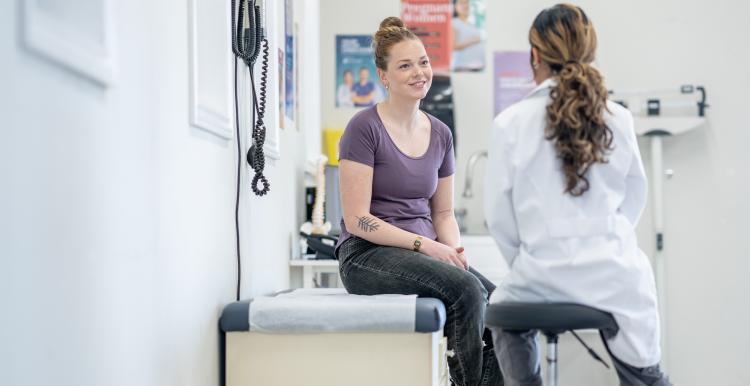Four things people want from the 10-Year NHS Plan

Based on recent trends in public feedback, our submission to the 10-Year Health Plan set out four priorities for patients, their families, and their carers.
1. Putting patients first
The Government has set out three shifts to help reform the NHS over the next decade. These are:
- Moving more care from hospitals to communities.
- Making better use of technology and shifting from an analogue to a digital NHS.
- Focusing on preventing sickness before people need treatment.
These shifts align with what lots of people want to see from the NHS in England, with easy access being the main thing people tell Healthwatch they want.
However, people’s needs, preferences, and choices must underpin these shifts. This includes a choice of where to be treated and options for digital and offline communications and services from NHS teams.
Choice of care
Giving people choice in healthcare means listening to, respecting, and prioritising their needs, which can get them the help they need, boost their perception of the NHS, and restore their confidence in the health service.
The NHS Constitution sets out the right for people to be involved in making decisions about their care, along with rights to have preferences met, and the right to choose where they receive healthcare.
However, people have shared that many NHS decisions feel weighted too far towards what works for teams delivering care. Although it is right that policies and reforms give NHS staff the support they need, this cannot be at the expense of people accessing the care they need in the way they need it.
People’s choice is often not just a matter of personal preference but essential to access due to communication requirements, affordability, or work or caring commitments.
"I haven’t had my hip replacement yet – on a waiting list. But I’ve been amazed that I've been able to choose to have my op at a local private hospital on NHS, 20 minutes from my home. The alternative was to travel to the NHS unit 45 minutes away. Well done NHS, for giving me patient choice." — Story shared with Healthwatch England
People want flexibility in appointment types, times, and types of professionals they can see.
Sometimes, they may choose continuity of care with the same professional, but on other occasions, they prefer to prioritise getting a quicker appointment.
In some instances, continuity of care does not have to mean with a single professional, but rather that the patient feels a sense of continuous service from the NHS.
People are open-minded about seeing different services or professionals as long as they are informed about their options, these options are genuinely accessible, and they feel understood and listened to by whoever they see.
What needs to happen?
In ten years, we want an NHS led by people's needs.
- If more care moves into the community, then existing hospital-based support, such as with travel costs, must follow the patient.
- If the NHS delivers more care through the NHS App in ten years, choice must be at the heart of this shift. People who prefer analogue communications must have that choice. The NHS App must do all it can to provide people with informed choices about the available options and services.
- If more people are to get care closer to their homes, healthcare leaders must ensure support is in place so that unpaid carers don't take on more support duties or incur new costs, such as travel costs or electricity from machines used at home.
- The NHS App must enable two-way communication, allowing people to give and receive updates on their condition, appointments, vaccinations and prescriptions, and to give real-time feedback on their experiences.
- The NHS App should provide more features, including real-time trackers for referrals and waiting times, easy access to 'customer support', and a better directory of services, including signposting to Healthwatch England and local Healthwatch services.
- The Plan must ensure that no one is left behind by digital care and that people can choose to receive any support provided through the NHS App in appropriate formats.
2. Getting the basics right
Although the NHS is made up of many organisations, it should feel like one coordinated and connected service to people accessing it.
But people have told us they can find it difficult to understand and navigate an often complicated and confusing health system. This includes people feeling bounced between teams who lack understanding of who does what, and what support people may need to access their care.
In particular, disabled people and those who have sensory impairments can find it harder to contact health teams in ways that work for them, and they often get healthcare in a format they can’t access, as their communication needs aren’t recorded on health systems.
Disjointed systems that don't “talk to each other” mean that people’s medical records, including communication needs, are not consistently recorded.
We’ve also heard stories of people whose NHS letters arrived after the appointment day or were sent to the wrong address, while some had their referrals lost in the system. Our recent work on administrative issues was based on feedback from people reporting alarming problems with medical records.
Inaccurate and missing information in people’s medical records can cause delays in receiving care and seriously affect patient safety.
“Exhausting and very annoying for me to have to start everything over when GPs can tend to be sceptical to patients’ descriptions of diagnoses and tests that are not on their records.” — Story shared with Healthwatch England
What needs to happen?
In ten years, we want the NHS to get the basics right.
-
By 2035, transitions across services should feel seamless, and reforms must simplify navigation for people so they do not have to repeat their stories to different teams.
-
Greater support with health literacy will also ensure the 10-Year Health Plan leaves nobody behind.
-
Investing in admin systems and hiring and training NHS care navigators would help wrap care around people’s needs, support navigation of NHS services, support the shift to digital care, and provide extra support with admin processes.
-
Strengthening the Accessible Information Standard (AIS) will ensure that services meet people’s communication needs and consistently record the formats in which they should receive their healthcare. This will prevent people from missing out on vital care.
3. Tackling health inequalities
People who already face inequalities are more likely to be affected by problems in the NHS.
- People from ethnic minority backgrounds, disabled people, unpaid carers, and women are more likely to face longer waits for and worse experiences of planned hospital care.
- People on lower incomes are less confident in accessing daytime GP appointments. They're also more likely to avoid attending dentist or other health appointments due to associated costs, such as the cost of a phone call, internet access, or travel costs.
- Neurodiverse people are more likely to report a negative experience of getting a referral from general practice to community and secondary care.
- Autistic people, visually impaired people, deaf people, those with dyslexia, and people relying on translators face persistent challenges receiving inaccessible communication from NHS teams.
- Rural communities are more likely to struggle to access GP services, mental health services and pharmacies.
All these examples exacerbate the lack of trust many communities feel in health and care services, including a reluctance to give feedback on experiences and to engage with services.
“I need a dental sign-off in order to continue essential treatment related to a cancer diagnosis. I am unable to find an NHS dentist and cannot afford private treatment therefore I cannot have the medication required to continue my treatment.” — Story shared with Healthwatch Dorset
What needs to happen?
In ten years, access to NHS services should be equitable, and everyone should have equal opportunities and support to get the help they need.
- We need to see concerted efforts to change the NHS into an equal and fair health service where everyone can access the care they need, regardless of factors like age, gender, or where they live.
- The 10-Year Plan should start by examining ways of ensuring that all forms of national data can be broken down by demographics. Right now, nationally collected data does not always break down the experiences of care by different groups, meaning that inequalities are often not visible.
- Patients who remain ‘analogue’ (due to digital exclusion from cost, low skills or disability), must not be left behind by a ‘digital NHS’ and still be able to use ‘offline’ channels. The NHS must provide people with alternatives as well, so that everyone can access services and receive communications via their preferred format, including in person, over the phone, or via letters.
4. Measuring people’s experience of care
Reducing waiting times for planned NHS care and in A&E departments has been a key focus for NHS leaders in recent years. This is important, and matters to patients, but it won’t happen overnight. Patients’ experience of waiting, comfort, choice of care, and communication with services are just as key.
NHS performance should be formally measured against patient experiences to understand where and why poor experiences exist – and, importantly, whether 10-Year Health Plan policies are working for people.
Current performance measures focus on hospital care and tend to measure numbers through the door and length of wait. But measuring four-hour waits in A&E or 18-week waits for elective appointments tells us nothing about people’s experiences while waiting, including the quality of non-clinical support they receive and their experiences across multiple pathways and services.
What needs to happen?
In ten years, NHS performance should be measured against the things that matter to people.
- The NHS 10-Year Plan should measure people’s experience of care as part of performance monitoring.
- This should include access to care, how much choice people have, the quality, quantity, and accessibility of communications from services, and whether the NHS buildings they visit are fit for purpose.
- An integration measure of how well services transition patients between each other will also be vital to ensure patients don’t have to repeat their story and that transitions are safe and planned.

